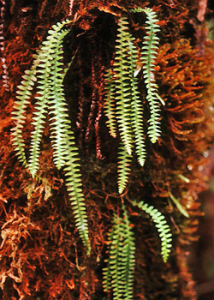Islands are home to nearly one-third of the world's plant species, despite covering just 5.3% of the Earth's land surface. That's according to a new groundbreaking study published in Nature on October 16 , co-authored by a University of Hawaiʻi at Mānoa botanist.

An international team of a dozen researchers analyzed data on more than 304,103 vascular (vascular plants are trees, ferns, and flowering plants; non-vascular plants are mosses, and liverworts) plants—essentially all species known to science worldwide. The team found 94,052 species are native to islands, and of these, 63,280 are endemic—found nowhere else in the world. This research provides the first comprehensive assessment of plants native and endemic to islands worldwide.
"This comprehensive study reveals the important role islands play in Earth's botanical richness," said study co-author and UH Mānoa School of Life Sciences Professor Emeritus Tom Ranker. "By quantifying the uniqueness of island flora and highlighting its vulnerability, this research underscores the urgent need for targeted conservation efforts to protect these irreplaceable hotspots of plant evolution."
Large tropical islands such as Madagascar, New Guinea and Borneo lead in endemic species counts, while oceanic archipelagos such as Hawaiʻi boast the highest proportions of endemic flora. Hawaiʻi stands out with 83% of its plant species being endemic to the state. However, individual Hawaiian Islands showed lower single-island endemism, meaning that a large percentage of flora are found on multiple islands in the state. Maui, for instance, has only 14% single-island endemics in its native flora.
Critical conservation needed

The study also highlighted the urgent conservation needs of island plants. Of the island endemics assessed by the International Union for Conservation of Nature, 51% are threatened, and 55% of all documented global plant extinctions occurred on islands.
Hawaiʻi faces significant conservation challenges. Its dry forests and other unique habitats are highly endangered. According to the Hawaiʻi Division of Forestry and Wildlife , Hawaiʻi is often referred to as the "Endangered Species Capital of the World." It said that more than 100 plant taxa have gone extinct, and over 200 are considered to have 50 or fewer individuals remaining in the wild. Officially, 366 of the Hawaiian plant taxa are listed as endangered or threatened, and an additional 48 species are proposed as endangered. While only comprising less than 1% of the U.S. land mass, Hawaiʻi contains 44% of the nation's endangered and threatened plant species.

Some examples of plants endemic to Hawaiʻi include:
- Doryopteris takeuchii , a type of fern endemic to Leʻahi (Diamond Head)
- Adenophorus periens or "pendant kihi fern," effectively extinct in the wild, though researchers at the National Tropical Botanical Garden are trying to propagate it
- Kokia cookei or "Kokiʻo," a flowering plant endemic to Molokaʻi
- Marsilea villosa or " ʻihiʻihilauākea," a fern that resembles a four-leaf clover
The study suggests that protected areas alone may be insufficient, calling for integrated approaches including habitat restoration, invasive species removal and ex situ conservation (preservation of biological diversity outside of its natural habitat) programs. Alarmingly, only 6% of islands supporting endemic species currently meet the UN's 30×30 conservation target.
"Our study underscores the global importance of Hawaiʻi's unique plant life. But these botanical treasures are under severe threat, with many species on the brink of extinction," Ranker said. "Hawaiʻi residents have a special responsibility to protect and restore our native ecosystems, not just for their beauty and cultural significance, but for their irreplaceable contribution to global biodiversity."
The School of Life Sciences is housed in UH Mānoa's College of Natural Sciences .
The post Islands host 1/3 of Earth's plant species, conservation needed first appeared on University of Hawaiʻi System News .






